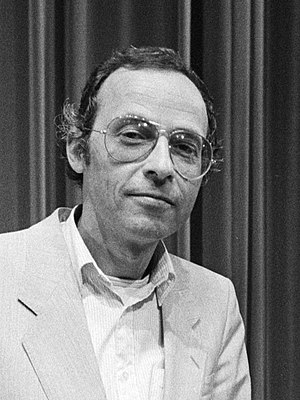Carel Weeber
| Carel Weeber | |
|---|---|
 Carel Weeber (1983).jpg Carel Weeber (1983).jpg Carel Weeber (1983) | |
| Born | December 3, 1937 Nijmegen |
| 🏳️ Nationality | Dutch |
| 💼 Occupation | Architect |
| 🏅 Awards | Rotterdam-Maaskantprize |
| 🌐 Website | rkd |
Carel José Maria Weeber (Nijmegen, December 3, 1937) is a Curaçaoan-Dutch architect.
Life and Works[edit]
In the first year of his life, his family moved to Curaçao. In 1955 they returned to the Netherlands by boat[1]. He studied Architecture at the Technische Hogeschool Delft, (now TU Delft)[1]. In 1966, shortly after graduating, he won the Prix de Rome[2] for Architecture with his plan for a new Central Station in Amsterdam. One of his first works was a 1969 holiday house in Veere, which was for a member of his family.
From 1970 to 2003 he was a professor[3] at the TU Delft Faculty of Architecture. At the same time he was also working as an architect. For some time he worked under his own name. He designed the Dutch pavilion at Expo 70[3] in Osaka he collaborated with J.B. Bakema of the architecture firm Van den Broek en Bakema. Later on he also designed a housing complex in Blijenhoek at the outer limits of down town Dordrecht. In 1977 he associated himself with the Architecture Firm of Jan Hoogstad, c.s. In 1988 he left them, following which he, with Jan Dirk Peereboom Voller, Pi de Bruijn and Frits van Dongen, established the Architecture firm Architecten Cie[4].
Weeber is known as a fierce opponent of the Nieuwe truttigheid[5] (New Craziness) in Dutch architecture. This was the building of small scale housing towards the end of the 70's, with his woonerfs. As a counter reaction he developed some collosuses. At the end of the 70's he developed a hospital for North Vietnam which was entirely prefabricated[6] in the Netherlands, then shipped to North Vietnam, and assembled there. Later another two hospitals followed in Guinee-Bissau and Tanzania. From 1993 till 1998 he was chairperson of the Association of Dutch Architects Bond van Nederlandse Architecten (BNA). In a questionnaire of theVolkskrant (1997) he was called out by his colleague architects as the 'worst architect' of the Netherlands.[7] Earlier that year he had launched the concept "Het Wilde Wonen" (Wild Living)[3] as a protest against the rigid Dutch housing developments, in an interview with Bernhard Hulsman, editor of NRC Handelsblad.[8] A tamed down variant of Wild Living appeared under the name "Gewild Wonen (Wanted living)".
From 2003 on he refers to himself as ex-architect.[9] 50 years after coming to the Netherlands, (2005) he returned to Curaçao[1], where he had designed a house for himself. Weeber is Knight of the Order of the Dutch Lion. In 2006 he was awarded the Rotterdam-Maaskantprijs.
Famous buildings[edit]
- Dutch Pavilion, World Expo Osaka 1970, with J.B. Bakema [3]
- De Pompenburg in Rotterdam (1977-1981)
- The controversial Black Madonna[3] in Den Haag, demolished in 2007
- Studentenflat 'de Struyck' (1996) on the Rijswijkseplein in The Hague;
- The Paperclip[3] in Rotterdam-Zuid, with which he won the Betonprijs
- The metrostations in Spijkenisse, with which he won the Nationale Staalprijs in 1986
- Prison at De Schie in Rotterdam
Famous neighborhoods[edit]
- Thamerdal IV, Uithoorn, 1997
Gallery[edit]
-
The Black Madonna in The Hague
-
The Paperclip in Rotterdam
-
Jail at De Schie
-
metrostation Spijkenisse
-
The Pompen Bridge
See also[edit]
Sources[edit]
- Barbieri, Umberto; de Heer, Jan (2003). Carel Weeber ʻexʼarchitect (in Nederlands). Uitgeverij 010. ISBN 9064505055. Search this book on
 ISBN 9789064505058 Search this book on
ISBN 9789064505058 Search this book on  .
.
- "Carel Weeber" (in Nederlands). 2021.
- Dings, Mieke (2006). De stad (in Nederlands). 010 Publishers. ISBN 9064505403. Search this book on
 ISBN 9789064505409 Search this book on
ISBN 9789064505409 Search this book on  .
.
- Nederlands, Architectuurinstituut (2005). Architectuur in Nederland: Architecture in the Netherlands. Jaarboek. Yearbook (in Nederlands). Van Loghum Slaterus. Search this book on

References[edit]
- ↑ 1.0 1.1 1.2 Nederlands 2005, p. 2002.
- ↑ https://prixderome.nl/winnaar/carel-weeber/
- ↑ 3.0 3.1 3.2 3.3 3.4 3.5 Dings 2006, p. 397.
- ↑ https://cie.nl/page/724/legacy
- ↑ https://www.architectuur.org/stroming_neorationalisme.php
- ↑ https://www.archined.nl/2005/10/carel-weeber-rekent-af/, 07 October 2005
- ↑ Collega's: Weeber slechtste architect, de Volkskrant, 13 september 1997
- ↑ Het wilde wonen; Carel Weeber wil af van het rijtjeshuis, NRC Handelsblad, 4 april 1997
- ↑ Barbieri 2003.
External links[edit]
- Architectuur.org: Oeuvre Carel (Carlos) José Maria Weeber
- Het Cultureel Woordenboek, encyclopedie van de algemene ontwikkeling, Kohnstamm en Cassee, ISBN 904140628X
This article "Carel Weeber" is from Wikipedia. The list of its authors can be seen in its historical and/or the page Edithistory:Carel Weeber. Articles copied from Draft Namespace on Wikipedia could be seen on the Draft Namespace of Wikipedia and not main one.





